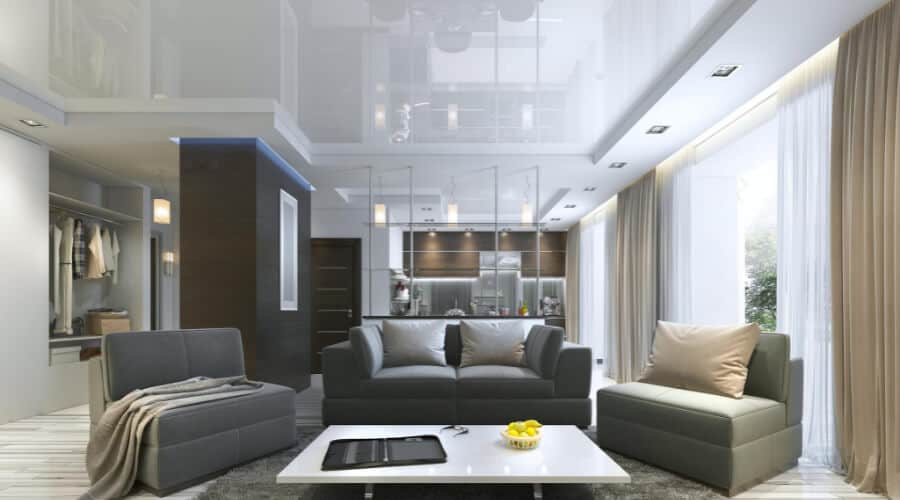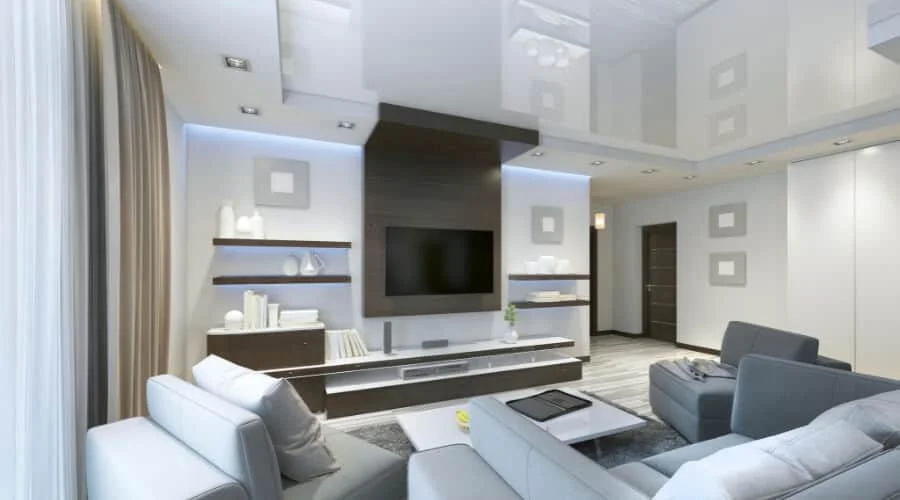Last Updated on July 25, 2023 By Emma W. Thomas
Old folks used mirrors on the ceiling for various reasons, including enhancing room lighting, creating an illusion of larger space, and as a decor trend. Some believed it brought positive energy or helped with sleep disorders. However, individual preferences and cultural influences also played a role in using mirrors in this manner.
Mirrors On The Ceiling – Why Old Folks Were Using Them
Mirrors on the ceiling are a vintage home décor trend that goes back several decades. Often, these mirrors were associated with luxury and glamour. However, there were practical reasons why older generations incorporated mirrors on the ceilings. Here are some noteworthy reasons:
- Enhanced Lighting: Mirrors are known for their unique ability to bounce light around a room. This property made them a favorite tool for enhancing natural lighting. By positioning a mirror on the ceiling, older folks managed to maximize the usage of sunlight during the day, reducing the need for artificial lighting and thus, saving energy.
- The Illusion of Space: Another prevalent reason for having mirrors on the ceiling was the visual trickery they provided. A ceiling mirror can make a room seem larger than its actual size. This was especially beneficial in smaller homes where space was at a premium, as mirrors could create the illusion of a more spacious interior.
- Artistic Appeal: Apart from utilitarian purposes, mirrors were also used as an artistic feature. Old folks used them to add a glamorous and luxurious aesthetic to their homes. The reflective surface of mirrors brought a unique character to their homes, adding a vintage touch.
- Temperature Regulation: Before the advent of modern heating and cooling systems, people had to find creative ways to regulate indoor temperature. Mirrors helped deflect heat during the summer months and retain it during winter, contributing towards maintaining a comfortable indoor temperature all year round.
- Spiritual Beliefs: Some cultures and traditions believe mirrors possess spiritual or protective qualities. In Feng Shui, for example, mirrors are used to deflect negative energy. Older generations often used this traditional wisdom to position ceiling mirrors strategically, aiming to foster prosperity and well-being.
| Enhanced Lighting | Mirrors bounce off and diffuse light around the room, making it brighter. |
| Illusion of Space | Mirrors on the ceiling make a room appear larger and more spacious. |
| Artistic Appeal | The use of mirrors adds a unique, glamorous aesthetic to the decor. |
| Temperature Regulation | Mirrors can help regulate indoor temperature by deflecting or retaining heat. |
| Spiritual Beliefs | Some traditional beliefs associate mirrors with spiritual protection and prosperity. |
How Are Mirrors Installed On The Ceiling?

Everybody enjoys talking about a ceiling mirror, but surprisingly enough, nobody talks about it as an improvement project. Mirrors are relatively easy to install as they add up a romantic and lustrous look to your interior. Don’t forget it also brings out some luxury in your ambiance. It provides you with fun and endless enjoyment, but be sure to have thoroughly researched the best large and heavy piece of mirror for your ceiling before installation. Be careful not to risk just any piece of glass because not all of them are safe for hanging on top of the roof. Here’s how to install a mirror on your ceiling effectively: installation of your ceiling mirror.
1. Choose A Ceiling Mirror:
This is one of the most critical factors as far as interior décor is concerned. Lighter-weight mirrors are the best because they are easy to hold up, even while fastening. The ceiling mirror tile comes in handy if you are looking for an easy and safer installation altogether. However, you can also consider reflective material so that you don’t end up breaking the bank. On one hand, they are relatively cheap, while on the other, they won’t give you the same satisfaction as real polished plate glass.
2. Prepare Your Ceiling Mirror:
Bearing in mind that a large, heavy piece of glass is what you’re dealing with, your safety comes first based on the choice of mirror you choose. Of course, you won’t be happy if the mirror accidentally loosens in the middle of the night and comes down crashing on you. Be careful during the entire installation process for a lovely interior. Some of the steps to safe installation include:-
- At regular intervals, screw a plywood backing or any other sturdy, flat surface onto the ceiling joists.
- Consider a custom-made frame and a combination of high-performance construction adhesives to hold up the ceiling mirror in place firmly. The glues are applied to the back of the ceiling mirror for a safe backing since it provides a safe and solid surface for attaching the ceiling mirror.
- A custom-made frame preferably made from hardwood holds the mirror in place as it is cut to fit the edge of the ceiling mirror.
After considering all three steps, you can now relax and enjoy your mirror on the ceiling without fear of any accidents.
Types Of Mirrors That Can Be Placed On The Ceiling:
Depending on different materials, there are several types of ceiling mirrors to choose from. Read on to find out.
| Type Of Mirror: | Description: |
| Glass | This mirror has dissected seams on the surface, which makes a significant difference from other ceiling mirrors. You cannot just mount it using similar methods to other mirrors since it uses unique aluminum rack systems. Special suspension brackets are also fixed to the ceiling at the same time in the same place you are mounting the steel rails. They are perfect for long service life and easy installation. |
| Polyvinyl Chloride | It is made of a unique PVC film that is glossy. As a mirror stretch ceiling, it reflects light well though considered as an imitation of an actual mirror on the ceiling. The most significant advantage is the fact that you won’t have to worry about the mirror breaking. |
| Aluminum | This mirror has dissected seams on the surface, which makes a significant difference from other ceiling mirrors. You cannot just mount it using similar methods like other mirrors since it uses unique aluminum rack systems. Special suspension brackets are also fixed to the ceiling at the same time in the same place you are mounting the steel rails. They are perfect for long service life and easy installation. |
| Polystyrene Mirror Plates | These ceiling mirrors are always in rolls when sold. The installation process begins right after leveling it under the load after you unwound it from the load. Bear in mind that you’ll find most of them having a posterior surface that is adhesive. Some lighting equipment will be incompatible with them since some extremely undesirable light sources may include halogen lamps. |
Other Options To Choose From Instead Of A Ceiling Mirror:
You don’t have to stress yourself out when looking to install a ceiling mirror anytime soon. You can get several options to choose from, especially if you are working on a fixed budget.
1. Specialty Hanging Mirrors:
They can also play the same role a ceiling mirror does. However, be sure that you’ll undoubtedly break the bank to get one. They are made from a reflective material that is lighter compared to polished plate glass and hung from a network of central supports that come together on top of your bed. It is similar to having a chandelier that does not provide light but instead reflects it. Please bear in mind that hiring a professional for the installation is the best and safest way, other than struggling by yourself and waking up to injuries and cuts from a fallen and poorly installed ceiling mirror. This is regardless of your choice of ceiling mirror.
2. Ceiling Mirror Tiles:
These are much easier and safer to attain a ceiling mirror effect, though the mirror products will not look as classy as polished plate glass mirror ceilings. They are not spacious enough, and most of them come with an adhesive that is pre-applied to the backing. After pulling off the shielding support film on the tile and marking out your tiling plan on the ceiling, you can start layering your tile according to your preference. Although your reflection won’t be completely uninterrupted, the big worry is that you’ll be distracted by the layers of the tiles when admiring your view.
Pros And Cons Of Ceiling Mirrors:

Having mirrors fitted on the ceiling can be very convincing, while at the same time tragic—no need to worry about that because we have all the facts detailed in this section. To help you in your decision on whether or not you can proceed with the move, we’ve listed some pros and cons of having mirrors on the ceiling to help you decide if you want them.
Pros:
- Mirrors on the Ceiling increase the size of the room visually. Additionally, this makes them perfect for smaller spaces, especially with ceilings that are not too high.
- They improve a room’s natural lighting as they reflect every ray of light. This makes them impeccable for rooms with windows that overlap the sunny side.
- The surfaces do not burn out or age when they emit the reflection of the sun.
- You can easily clean the mirrored surfaces using common detergents. You can use napkins or damp flannel clothes to dust and clean them for the polystyrene mirror plates.
- They have many options for creating them as they also fit into all types of interiors.
- You’ll enjoy an unlimited flight of fantasy because you can also experiment with different shapes detailed on the glass.
Cons:
- As fragile as glass is, it cannot withstand hard objects or strong shocks. However, only a mirror stretch ceiling can withstand taps and bumps.
- Solid and heavy as glass is, it cannot be directly glued to a plaster. It will easily fall off and crush the people below it.
Conclusion:
Having mirrors on the ceiling is slowly regaining popularity day by day and is almost becoming a trend. We hope that this article has helped you understand why people since the 17th-century use mirrors on their ceilings and made you consider getting one for yourself too
References:
https://www.quora.com/What-is-the-deal-with-that-whole-mirror-on-the-ceiling-thing-from-the-70s
Emma is a graduate of Domestic Science or Family and Consumer Sciences (Home Economics) from the University of Wisconsin. She has 7 years of experience Working with the strategic section of BestBuy and now writing full-time for Homeeon.
From Managing the Home, Interiors, Cleaning, and Exteriors to Gardening and everything about Making A Home Liveable – is her passion and this Homeeon is the result of this.
Emma loves decorating her home with the best stuff found online. She cares about quality over anything and writes reviews about them here in Homeeon. Get in touch with her over Pinterest.
Keep reading her blogs.

